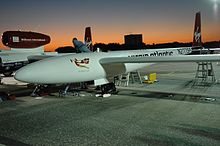
In aerospace engineering, an aircraft's fuel fraction, fuel weight fraction,[1] or a spacecraft's propellant fraction, is the weight of the fuel or propellant divided by the gross take-off weight of the craft (including propellant):[2]
The fractional result of this mathematical division is often expressed as a percent. For aircraft with external drop tanks, the term internal fuel fraction is used to exclude the weight of external tanks and fuel.
Fuel fraction is a key parameter in determining an aircraft's range, the distance it can fly without refueling. Breguet’s aircraft range equation describes the relationship of range with airspeed, lift-to-drag ratio, specific fuel consumption, and the part of the total fuel fraction available for cruise, also known as the cruise fuel fraction, or cruise fuel weight fraction.[3]
In this context, the Breguet range is proportional to
- ^ Brandt, Steven (2004). Introduction to Aeronautics: a Design Perspective. AIAA (American Institute of Aeronautics & Ast). p. 359. ISBN 1-56347-701-7.
- ^ Vinh, Nguyen (1993). Flight Mechanics of High-Performance Aircraft. Cambridge: Cambridge University Press. p. 139. ISBN 0-521-47852-9.
- ^ Filippone, Antonio (2006). Flight Performance of Fixed and Rotary Wing Aircraft. Elsevier. p. 426. ISBN 0-7506-6817-2.

